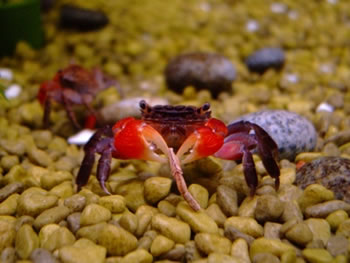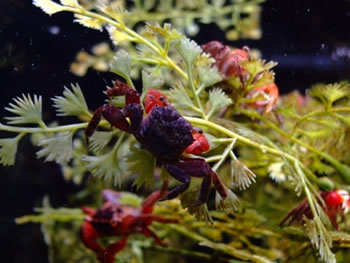Breeding Red Clawed Mangrove Crabs
Raising Red Clawed Mangrove crabs from tiny eggs, through the larvae stage and into impressive adults is not the easiest project you can venture, but it’s not impossible either.
To begin with, you will of course need a female Mangrove crab and her eggs. Female mangrove crabs often get eggs if they are kept in a holding aquarium with males. To successfully raise the frail larvae you will also need a separate rearing aquarium where conditions can be kept optimal and there are no predators present. The breading aquarium can be a regular aquarium with a capacity of at least 100 litres. Place a 2 cm thick layer of fine sand at the bottom. To make sure the aquarium is properly oxygenated and circulated equip it with air stones or similar. Take water and bogwood from the already running aquarium and use it to cycle the rearing aquarium. Also add about 1 tablespoon salt per 1 litre water. Recommended gravity of the water is 0.010 ppm. The gravity can be checked with a hydrometer. Calibrate the heather, connect the lights to a timer, place a hatchery for artemia in the aquarium and buy high quality fluid food. Be vigilant when doing these things. Small things like this might seem inconsequential, but providing the right temperature, nutrition and amount of light is crucial when raising Red Clayed Mangrove crab. Put a piece of cork or similar in the aquarium to provide the female Mangrove crab with an opportunity to climb out of the water.
The female Red Clawed Mangrove crab will carry her eggs under her wide tail for about three weeks. The eggs will be red at first and then slowly change colour during the brooding. You know when the hatching is near, since the eggs will turn grey. This is the signal for you to put the female into the breeding aquarium. Keep her in there until the all the eggs have hatched.
|
Your Red Clawed Mangrove crab larvae will moult approximately every third day. After the first moult it will be easier to distinguish the different parts of the crab larvae, like the tail. The larvae are called zoea during the first stage of their life outside the egg, and megalopas during the second. Megalopas are bigger and wider than zoea, with a tail that is thicker and straighter. Megalopas are also lighter in colour. Notice how zoeas and megalopas move around in the aquarium in two totally different manners. The zoea groups move very quickly from one place to another, as if they were swimming away from something dangerous. Megalopas swim in a more calm and stable way.
The first stages of the larvae life is tuff on them, and you should not be surprised if a lot of them die. Don’t allow dead larvae to contaminate the aquarium. High levels of nitrite and nitrate are extremely unhealthy for all the inhabitants. You might have to do very frequent water changes if your filtration is not working properly.
After a few weeks the surviving larvae will be looking less and less like larvae and more and more like tiny Red Clawed Mangrove crabs. They will probably not swim around as much as when they were younger. Instead they will walk on the sand or gather on the bogwood or other surfaces. It might take a while before they figure out how to properly use their legs and you may see them try to walk around in a sort of upside down style.
When the crabs have become even bigger and look like tiny copies of their parents it’s advisable to supply them with several pieces of cork. This way they can climb out of the water and try out life on the surface. They will moult about every 7th to 10th day. When the crabs are no longer hunting the artemia you can remove the artemia hatchery from the aquarium. Start feeding your crabs flake food, small granulates and frozen bloodworm. It’s still extremely important to monitor the water conditions. As the crabs grow older it’s time for you to gradually decrease the salinity in the aquarium until there is no salt at all in the water. After a few months the crabs will probably be about 1 cm and you can start telling which sex they are. Suggested food is flakes, bloodworm, granulates and vegetables.
I hope these guidelines and suggestions will prove helpful to you and that you will succeed in breeding Red Clawed Mangrove crabs. It might require some work, but it is truly great watching these little creatures grow up from tiny eggs to big sturdy crabs. Keeping Mangrove crabs that you have followed throughout their entire life is a very special feeling.
Didn't find the info you were looking for? Register for free and ask your question in our Aquarium forum !
Our knowledgeable staff usually responds to any question within 24 hours
Related Articles
Amano shrimp- Information about Amano shrimpAmano Algae Eating Shrimp - An article about the algae eating Amano shrimp
Apple snail - An introduction to apple snails.
Aquarium crabs - A guide to aquarium crabs
Black Mystery Snail - An introduction to the Black Mystery Snail
Breeding Crayfish - basics too crayfish breeding
Freshwater shrimp - Information about Freshwater shrimp
Ghost shrimp - Information about Ghost shrimp
Malaysian Rainbow Shrimp - Information on how to keep and breed this shrimp species.
Red Cherry Shrimp - A guide to this Algae eating shrimp.
Red clawed lobsters - A short overview of red claw lobsters (crayfish)
Red Nosed Shrimp - information on keeping this shrimp in aquarium.
Snails: Friend or Foe in the Aquarium? - The biology of snails. Their advantages and disadvantages in an aquarium. How to keep them in check.


